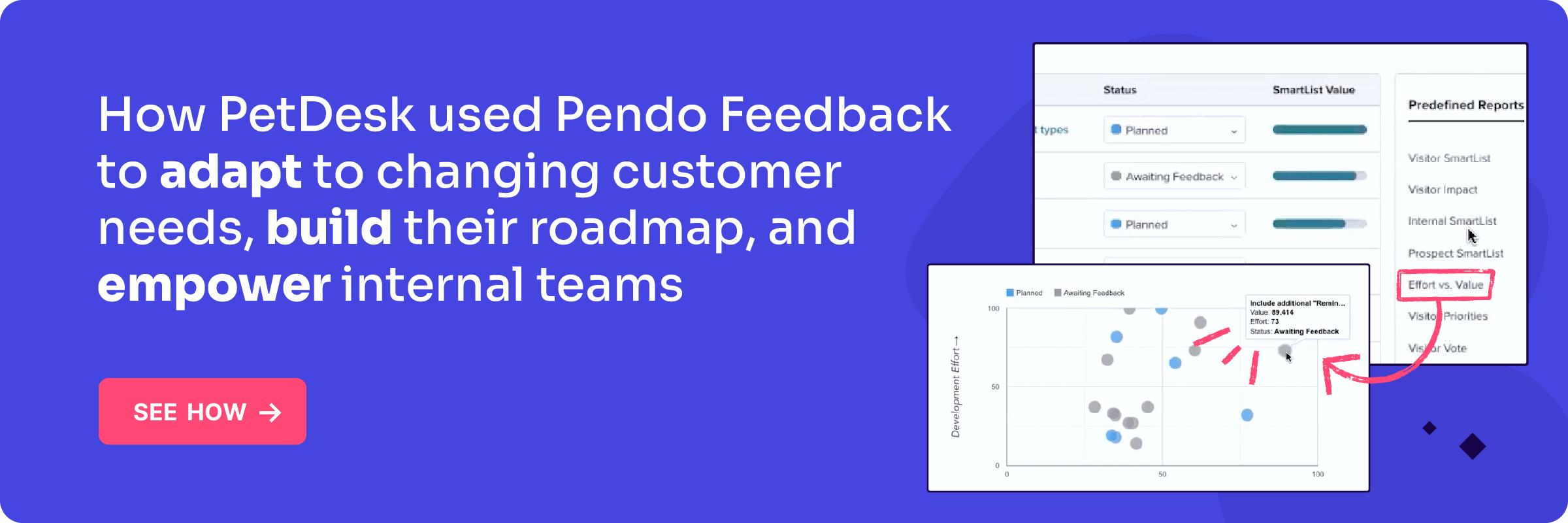For PMs, product feedback often feels like the ultimate frememy. You love product feedback, you need product feedback, but sometimes it feels like you’re being attacked with a never-ending firehose of, ‘Can you just…’ and ‘It would be nice if…’
This is a very common feeling for product managers, but there are some simple ways to help end the madness and make product feedback work for you, not against you.
The problem: feedback is everywhere
Most product managers are familiar with the feeling of feedback ‘whack-a-mole.’ When customers care about your product and prospects see it for the first time, you can guarantee they will share thoughts, opinions, and product improvements in many different ways and with people across your organization.
Very often this data will end up in multiple places–from Trello boards and spreadsheets to Jira tickets, emails, and a mountain of notifications in Slack. Yikes.
Feedback is an extremely valuable source of information for your product decisions, but it’s unusable if it’s scattered across different teams and pieces of software.
Centralizing feedback is better for everyone
One of the best things you can do is centralize your product feedback. When you have a central location for feedback, the magic will start to happen (well, I can’t promise real magic but it will certainly feel like it).
For a start, you will be able to trust your feedback data and use it confidently. When feedback is all over the place, it’s impossible to get a handle on the full picture. You miss vital information and can easily end up skewing your product roadmap toward the teams, customers, and prospects that simply shout the loudest.
A central location means you have a place to go when you need to delve deeper into what people are saying about your product. With a little organization thrown in, a central feedback location becomes a library–a wealth of data that’s accessible whenever you need it. It also provides structure to other teams and you can even invite customers to join in. When everyone knows where to submit feedback, it creates a better experience and helps build trust with the product team, too.
Centralizing product feedback fuels better communication
One of the most overlooked parts of product feedback is closing the feedback loop. We often think about collecting feedback, and forget that communicating back is just as important. When you centralize your feedback data, you are able to provide responses in a more controlled way than if you have scattered requests on a day-to-day basis.
A single location also allows you to understand the top pain points in your product across all sources. If you are viewing pieces of feedback in isolation, you miss the deeper level of insight you gain by looking at product feedback as a complete data set. For example, you can’t know how impactful any potential product changes are going to be if you are only working with a very small set of information.
How and when you communicate back should always form part of your product feedback process. Which brings me to my next tip: creating a Product Feedback Policy.
Create a Product Feedback Policy
As part of your move to centralize your product feedback, it’s incredibly helpful to write a Product Feedback Policy to share outside of the product team. This is a simple document that explains where product feedback should be submitted, how the product team uses it, and when folks can expect communication back.
Setting expectations in this way not only takes a lot of work off of your plate, but it also puts you back in control of how and when to respond to feedback requests. Adding a little structure is efficient, helps support all stakeholders, and makes product feedback data scalable and usable–unlike when it’s scattered and ad-hoc. Here’s Pendo’s Product Feedback Policy for some inspiration.
How product operations can help
Product operations is a relatively new function that has exploded in popularity in recent years. In our latest State of Product Leadership report, we continued to see growth in the number of organizations that have this dedicated role or team.
The collection and use of product feedback is a common area where we see product ops teams providing support for product managers. If you already have a product operations team (or plan to hire one), talk to them about the feedback process. Alternatively, assigning a member of the product team to own this area of work is also highly beneficial.
What to use to centralize your product feedback
Hopefully, you’re now convinced that centralizing your product feedback will be a huge win–who wouldn’t want to leverage one of the most valuable sources of information we have as product managers?
If you’re a smaller organization, pick a location and piece of software that’s going to work best for you and your teams. As you scale, it might be time to look at scalable feedback solutions.
If you’d like to talk to an expert at Pendo, you can book a free demo here. We’d love to talk to you to understand your feedback challenges and show how Pendo Feedback can help you create a centralized, actionable, and scalable process for your feedback data.


